TNAU Agritech Portal :: Crop Protection
 Chilli thrips: Scirtothrips dorsalis Chilli thrips: Scirtothrips dorsalis
| Symptoms of damage |
- The infested leaves develop crinkles and curl upwards
- Elongated petiole
- Buds become brittle and drop down.
- Early stage, infestation leads to stunted growth and flower production, fruit set are arrested
|
Chilli thrips infestation - upward curling
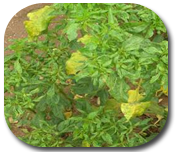 |
Chilli thrips infestation - upward curling
 |
|
| Identification of pest |
- Nymphs: Tiny, slender, fragile and straw yellow in colour
- Adult: with heavily fringed wings
|
Adult

|
|
| Management |
-
Inter crop with agathi Sesbania grandiflora to provide shade which regulate the thrips population
-
Do not grow chilli after sorghum – more susceptible to thrips
-
Do not follow chilli and onion mixed crop – both the crops attacked by thrips
-
Sprinkle water over the seedlings to check the multiplication of thrips
- Treat seeds with imidacloprid 70% WS @ 12 g /kg of seed
-
Apply carbofuran 3% G @ 33 kg /ha or phorate 10 % G @ 10 kg/ha or spray any one of the following insecticide
|
| Insecticide |
Dose |
| Imidacloprid 17.8 % SL |
3.0 ml/10 lit. |
| Dimethoate 30 % EC |
1.0 ml/lit. |
| Emamectin benzoate 5 % SG |
4 g/10 lit. |
| Ethion 50 % EC |
2.0 ml/lit. |
| Fipronil 5 % SC |
1.5 ml/lit. |
| Oxydemeton –Methyl 25 % EC |
1.0 ml/lit. |
| Phosalone 35 % EC |
2.0 ml/lit. |
| Spinosad 45 % SC |
3.2 ml/10 lit. |
| Thiacloprid 21.7 % SC |
6.0 ml/10 lit. |
|
Top
 Green peach aphid: Myzus persicae Green peach aphid: Myzus persicae
| Symptoms of damage |
- The infested plants turn pale with sicky appearance.
- The leaves curled and crinkled
- Honeydew excrete - development of sooty mould
- Stunted growth of the plant
|
Green peach aphid infestation - Crinkling
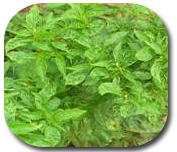 |
Green peach aphid infestation - Crinkling
 |
|
| Identification of pest |
- Nymphs initially are greenish, but soon turn yellowish.
- Adults – yellowish green in colour
|
|
| Management |
- Treat seeds with imidacloprid 70% WS @12 g /kg of seed
- Apply phorate 10 % G @ 10 kg/ha or spray any one of the following insecticide
|
| Insecticide |
Dose |
| Carbosulfan 25 % EC |
1.0 ml/lit. |
| Fipronil 5 % SC |
1.0 ml/lit. |
| Imidacloprid 17.8 % SL |
3.5 ml/10 lit. |
| Oxydemeton –Methyl 25% EC |
1.6 ml/lit. |
| Phosalone 35 % EC |
2.0 ml/lit. |
| Quinalphos 25 % Gel |
1.0 ml/lit. |
| Quinalphos 25 % EC |
1.0 ml/lit. |
|
Top
 Tobacco cutworm: Spodoptera litura Tobacco cutworm: Spodoptera litura
| Symptoms of damage |
-
Newly hatched larvae scrap the green matter in the leaf
-
Affected leaf looks like a papery white structure
-
Later instar larvae feed by making small holes
-
In severe infestations they feed voraciously on the entire lamina, petiole and some times
-
even the tender twigs on the terminal shoots of plants.
-
Also feed on the floral parts and bore into the fruits.
|
| Identification of pest |
|
Larva
- Young caterpillars are light green with black head or black spots
- Gregarious in the early stages
- Grown caterpillars are grey or dark brown
Adult
- Forewings – brown colour with wavy white marking
- Hindwings- white colour with a brown patch along the margin
|
| Management |
-
Plough the soil to expose and kill pupae
-
Castor as a trap crop
-
Set up pheromone trap @ 15/ha
-
Collect and destroy the egg masses, gregarious larvae and grown up caterpillars
-
Spray SINPV @ 1.5*10 12 POB/ha in evening hour
|
| Insecticide |
Dose |
| Emamectin benzoate 5 % SG |
4 g/10 lit. |
| Flubendiamide 20 WDG |
6.0 g /10 lit. |
| Indoxacarb 14.5 % SC |
6.5 ml/10 lit. |
| Novaluron 10 % EC |
7.5 ml/10 lit. |
| Spinosad 45 % SC |
3.2 ml/10 lit. |
| Thiodicarb 75 % WP |
2.0 g/lit. |
|
Top
 Gram caterpillar: Helicoverpa armigera Gram caterpillar: Helicoverpa armigera
| Identification of pest |
Larva feeding
 |
Larva feeding
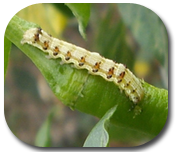 |
Adult
 |
Adult
 |
|
- Eggs – are spherical in shape and creamy white in colour, laid singly
- Larva - shows colour variation from greenish to brown
- Pupa – brown in colour, occurs in soil, leaf, pod and crop debris
|
- Adult - Female brownish yellow stout moth
- Male – light greenish in colour
|
| Management |
|
| Insecticide |
Dose |
| Emamectin benzoate 5 % SG |
4 g/10 lit. |
| Flubendiamide 20 WDG |
6.0 g /10 lit. |
| Indoxacarb 14.5 % SC |
6.5 ml/10 lit. |
| Novaluron 10 % EC |
7.5 ml/10 lit. |
| Spinosad 45 % SC |
3.2 ml/10 lit. |
| Thiodicarb 75 % WP |
2.0 g/lit. |
|
Top
 Yellow mite or muranai mite: Polyphagotarsonemus latus Yellow mite or muranai mite: Polyphagotarsonemus latus
| Symptoms of damage |
- Downward curling and crinkling of leaves
- Leaves with elongated petiole
- Stunted growth
|
Yellow mite infestation - downward curling of leaves
 |
Yellow mite infestation - downward curling of leaves
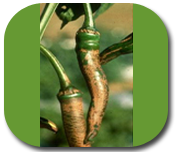 |
|
| Identification of pest |
- Oval shaped eggs and white in colour
- Eggs glued firmly on the leaf surface
- Nymphs white in colour
- Adult : large, oval and broad and yellowish in colour
|
Yellow mite - Adult
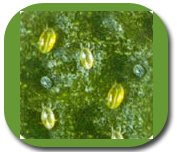 |
|
| Management |
|
| Insecticide |
Dose |
| Buprofezin 25 % SC |
8.0 ml/10 lit. |
| Chlorfenapyr 10 % SC |
1.5 ml/lit. |
| Diafenthiuron 50 % WP |
8.0 g/10 lit. |
| Dimethoate 30 % EC |
1.0 ml/lit. |
| Ethion 50 % EC |
2.0 ml/lit. |
| Fenazaquin 10 % EC |
2.0 ml/lit. |
| Fenpyroximate 5 % EC |
1.0 ml/lit. |
| Hexythiazox 5.45 % EC |
8.0 ml/10 lit. |
| Milbemectin 1 % EC |
6.5 ml/10 lit. |
| Oxydemeton –Methyl 25 % EC |
2.0 ml/lit. |
| Phosalone 35 % EC |
1.3 ml/lit. |
| Propargite 57 % EC |
2.5 ml/lit. |
| Quinalphos 25 % EC |
1.5 ml/lit. |
| Spiromesifen 22.9 % SC |
5.0 ml/10 lit. |
|
Top
|

